Did you know that almost 85% of drownings with kids could have been stopped? This could happen if people around knew how to act right away. Learning about life-saving tips and how not to get in the way during emergencies is crucial. By doing so, we can avoid many sad events and save lives. This piece will give you important rules and advice to help in dangerous situations.
Learn to respond well and helpfully when someone is trying to rescue another. We want to make sure your actions help the rescue team instead of making things harder. Our mission is to teach you the Tips to Prevent Impeding an Attempt to Save Life. We aim to make you an important and active member in any emergency situation.
Avoiding Interference in Emergency Situations
In emergency situations, you may want to help right away. But it’s vital to find a balance. You must allow experts to work without getting in their way. For rescuers to be effective, avoiding obstacles is key.
Sometimes, trying to help can actually create more problems. Crowding at an accident scene can prevent rescue teams from reaching those in need. It’s crucial to stay back and not get in the way of life-saving efforts.
“The most important step you can take in an emergency is to stay out of the way and let the professionals do their job.” – Red Cross Canada
Knowing how to avoid being a hindrance can make you a better support during emergencies. Here are some tips:
- Stay Calm: Panicking only leads to more trouble.
- Listen to Authorities: Always follow what emergency workers tell you.
- Keep a Safe Distance: Make sure you’re not blocking access.
- Offer Help if Asked: Only help out when rescuers ask you to.
Awareness and control are crucial to not interfere with rescues. By understanding your role, you help make rescue efforts faster and safer.
Understanding the Importance of Self-Preservation
In times of crisis, self-preservation in emergencies is key. It’s important to keep yourself safe so you’re not another person needing rescue. Sometimes, we want to help others right away. But, taking actions without thinking can put both you and them in more danger.
Staying focused on self-preservation in emergencies means making smart choices. For example, staying away from danger or waiting for experts can save lives. This way, you help rescue efforts and don’t add to the emergency workers’ load.
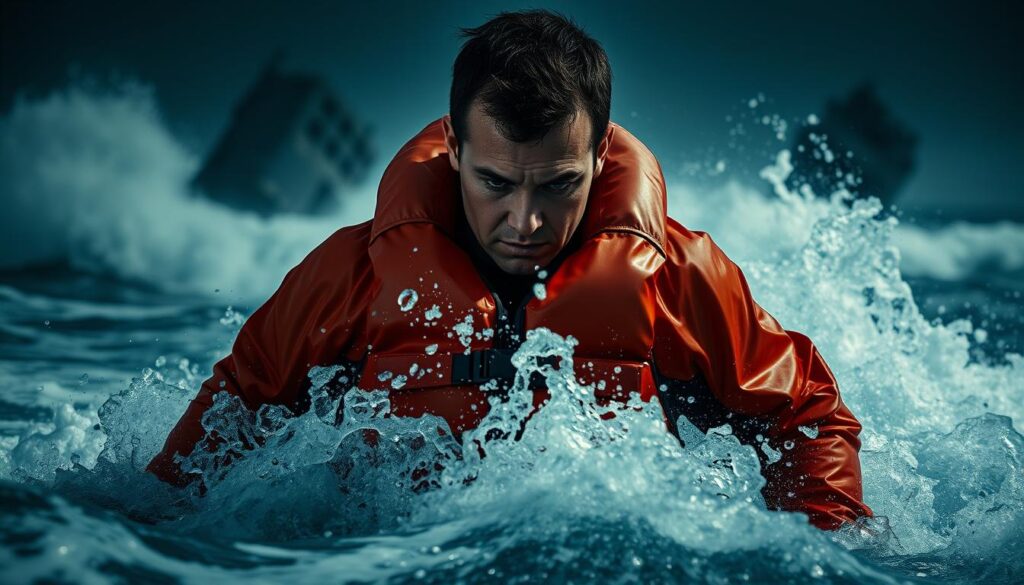
It’s important to know the difference between being heroic and being reckless. The urge to help is good, but prioritizing personal safety is key. Making sure your actions won’t make things worse is part of smart self-preservation.
Knowing how to preserve yourself in emergencies can really help with rescue efforts. Sometimes, the best way to help others is to make sure you’re safe first.
Here’s a comparison of self-preservation techniques versus reckless attempts:
| Action | Outcome |
|---|---|
| Stay out of hazardous areas | Lower risk of becoming a victim |
| Wait for professionals | Efficient and safe rescue operations |
| Immediate rush to help without assessment | Increased danger for both rescuer and victim |
| Using appropriate safety gear | Enhanced survival chances |
Tips to Prevent Impeding an Attempt to Save Life
Learning how to help in emergencies without getting in the way is very important. If you know the emergency signs and can communicate clearly and calmly, you can really help save someone.
Recognizing Signs of Distress
It’s vital to spot someone who needs help fast. Look for signs of panic, strange acting, or if someone is struggling to stay afloat. Knowing what to look for and acting quickly can change the outcome and help rescuers.
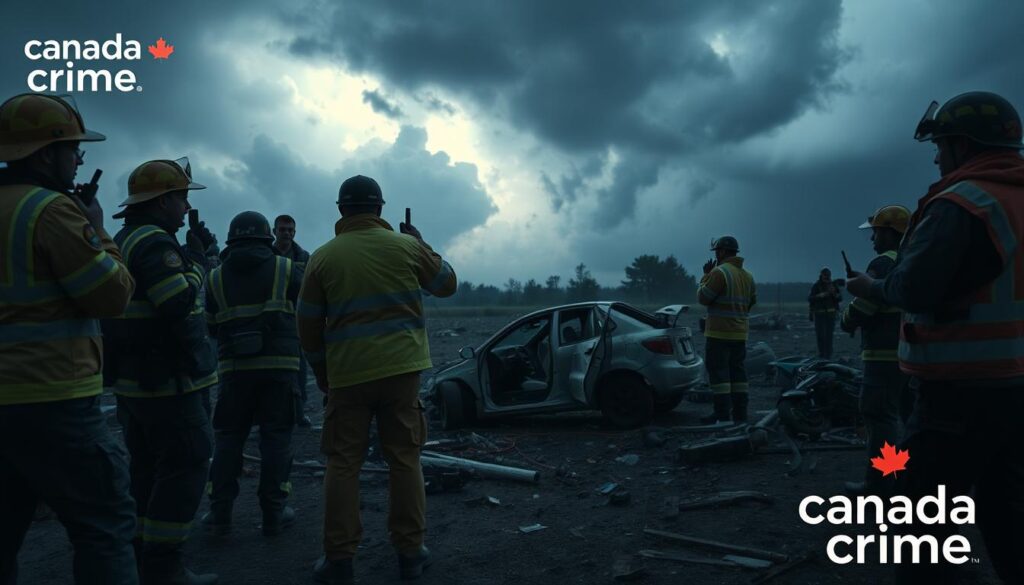
To lower the risk of harm, be alert and act if you see anything odd. Spotting these signs early can stop things from getting worse. For more information, check out the CDC’s suicide prevention resource.
Effective Communication During a Rescue
Talking clearly and directly is key in a rescue. Tell the pros where the trouble is and what’s happening. Stay calm and share what’s needed quickly. This helps ensure rescuers know how to help best.
Also, keep onlookers calm and informed while the rescue is happening. This keeps everyone safe and avoids extra problems that can get in the way of the rescue.
When you can spot emergency signs and talk effectively during a rescue, you make a big difference. Your actions can support rescue teams and might even save a life.
The Drowning Chain of Survival
Knowing how to prevent drowning is key if you enjoy the water. It’s made of steps that cover before, during, and after an incident. By staying informed and ready, you can keep water fun safe.
Preventing Drowning Incidents
Watching over swimmers non-stop is crucial. Whether you’re at a pool, the beach, or a lake, make sure a keen eye is on everyone. If possible, this should be a trained lifeguard. It’s also important to teach everyone the dos and don’ts of water safety.
Providing Flotation Devices
Flotation devices are lifesavers in rescue attempts. Make sure pools and other water spots have life vests and other aids ready. These tools help keep people above water and make rescues smoother.
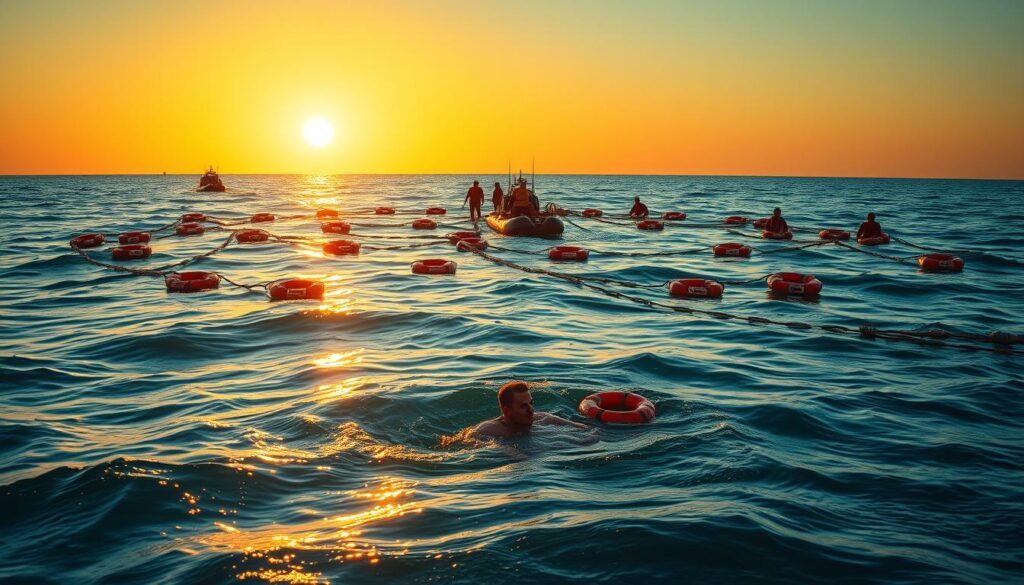
Best Practices to Assist in Saving Lives
When saving lives, following the best practices in rescue is key. This ensures everyone’s safety. By sticking to well-known protocols and techniques, you can help someone in need safely.
The 4 As of Rescue
The 4 As stand for Awareness, Assessment, Action, and Aftercare. These steps help you analyze the situation, plan, carry out the rescue, and then provide care afterward.
- Awareness: Notice the emergency and decide if you need to act.
- Assessment: Think about the water, wind, what you can see, and your own skills before stepping in.
- Action: Pick the safest way to help based on what you’ve assessed. Try to help without making contact if you can.
- Aftercare: After getting them to safety, give first aid and care until the experts arrive.
Non-Contact Rescue Techniques
Non-contact rescue methods keep rescuers safe. You can help people without touching them, which lowers the risk of danger. A plan called Talk, Reach, Throw, Row helps decide what to do based on the situation. Learn more about these methods here.
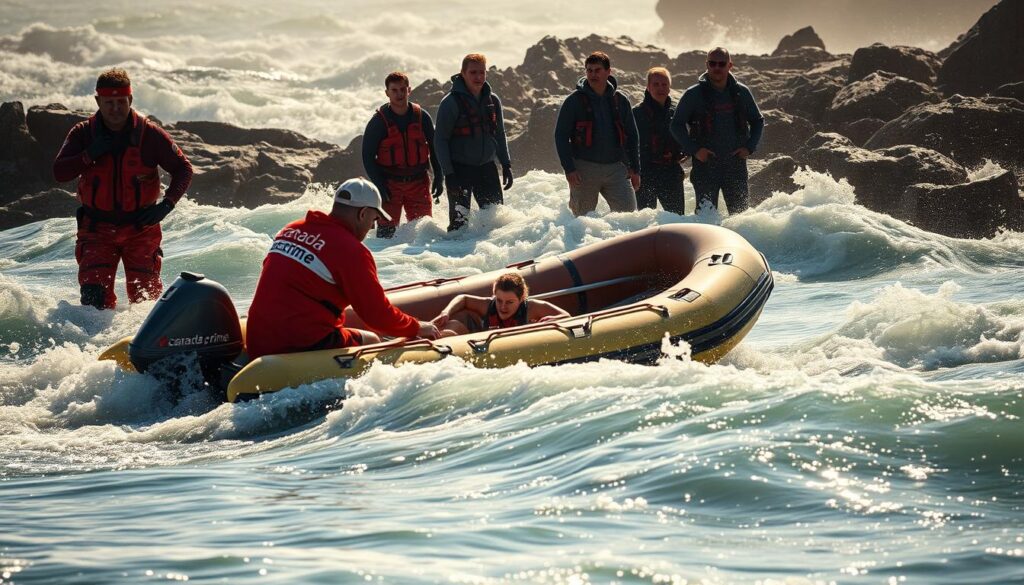
Knowing and using these methods is a big part of rescue best practices. It makes sure you’re ready and careful when trying to save lives. This plan gives you the tools to respond well in emergencies.
| Rescue Technique | Description | Safety Level |
|---|---|---|
| Talk | Speak and calm the person; guide them to safety. | Safest |
| Reach | Give them something to grab to pull them to safety. | Very Safe |
| Throw | Throw a life-saving device they can hold onto. | Safe |
| Row | Get to them in a boat and bring them back safely. | Moderately Safe |
Using these techniques and understanding non-contact rescues can make you more confident in emergencies. Keep learning to be ready for any rescue situation that comes up.
How to Support Rescue Efforts Effectively
In times of crisis, your role can be very important. Knowing when to help and when to stay back ensures you’re not in the way. Here are some tips to help emergency teams effectively:
- Maintain a safe distance from the rescue scene. This lets emergency teams have the space to work without obstacles.
- Provide clear information to emergency services. Accurate details can help them plan and act more effectively.
- Follow instructions from emergency personnel. They know how to handle these situations, so listening to them helps everything go smoothly.
- Offer assistance only when requested. Sometimes, the best way to help is just by keeping out of the way and letting the pros work.
- Keep calm and composed. Being steady can help keep things orderly, even when it’s chaotic.
These tips highlight the right way to act as a bystander. Teaching others these methods helps build a community that supports rather than hinders rescues.
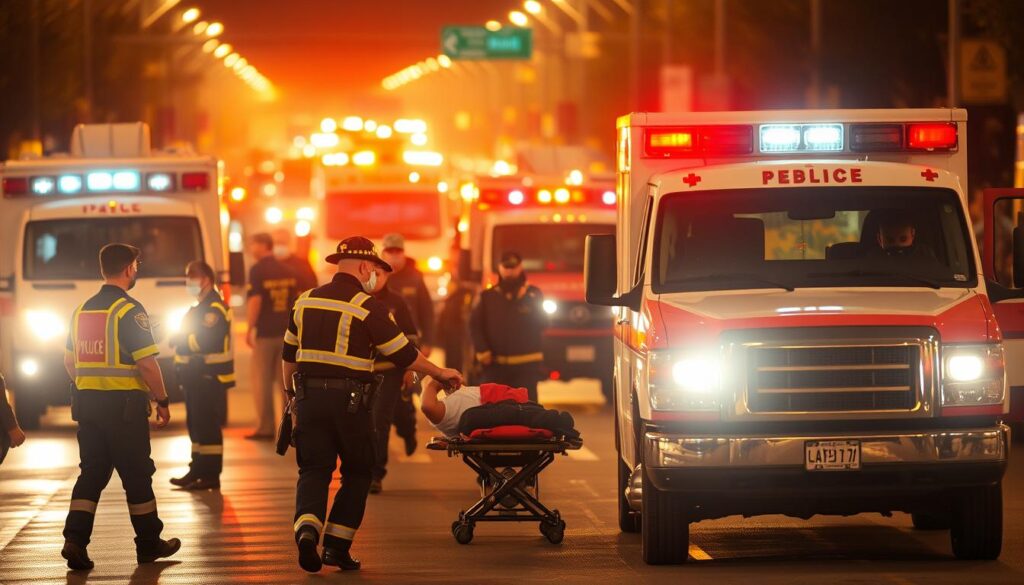
Supporting emergency rescues well combines staying informed, staying calm, and following professional instructions. Even if it seems like you’re not doing much, what you do is critical for successful rescues.
By keeping these guidelines in mind, you play a valuable part in making sure rescue missions succeed. This helps those in need get the quick and efficient aid they require.
| Key Actions | Importance |
|---|---|
| Maintaining distance | Provides space for responders |
| Providing clear information | Prepares responders for action |
| Following instructions | Ensures smooth operation |
| Assisting when requested | Avoids unnecessary interference |
| Staying calm | Maintains order |
Ice Safety and Cold Water Facts
Winter activities like ice fishing, skating, and snowmobiling are popular in Canada, yet they’re not without risks. Knowing essential ice safety tips and cold water survival techniques is key to your safety. This knowledge is crucial for both seasoned enthusiasts and beginners to winter sports.
Always check ice thickness before going on it. You need at least four inches thick for walking or skating, five inches for snowmobiles, and eight to twelve inches for cars. Look for signs of dangerous ice like cracks, slush, or discolored patches. These could mean the ice is weak.
“Remember, clear blue ice is the strongest, while white or cloudy ice is weaker. Always carry safety gear, like ice picks and a throw rope, when venturing onto frozen water bodies.”
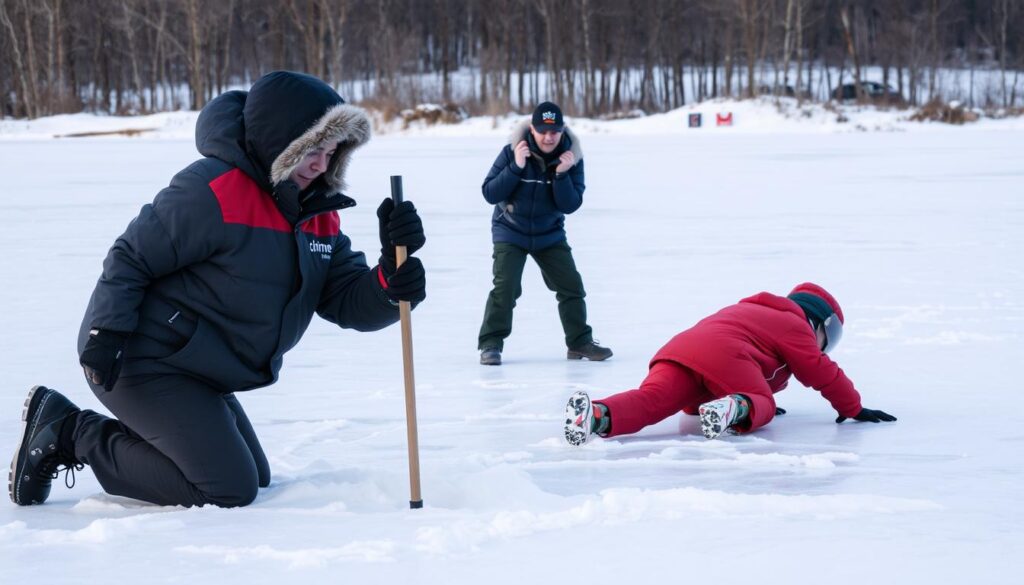
It’s important to know about cold water shock too. Falling into icy water causes your body to gasp, your heart rate to go up, and breathing to get fast. This can all lead to drowning if you’re not careful. Wear a life jacket that fits right to help stay afloat and keep warm.
Learning how to save yourself or signal for help is critical. Knowing hand signals and how to pull yourself out of the water using the “kick and pull” method will prepare you better.
| Ice Thickness | Activity |
|---|---|
| 4 inches | Walking or skating |
| 5 inches | Snowmobile or ATV |
| 8-12 inches | Car or small pickup |
| 12-15 inches | Medium truck |
Emergency Response Techniques
In an emergency, knowing the right actions can save lives. You’ll learn about CPR and using AEDs here.
Cardiopulmonary Resuscitation (CPR)
CPR is vital for saving someone facing a grave threat. Below, you’ll find the key steps for performing CPR:
- Check Responsiveness: Tap the victim and shout, “Are you okay?”
- Call for Help: Dial 911 or tell someone else to do it.
- Begin Chest Compressions: Put your hands on the middle of the chest. Push hard and fast, 100-120 times a minute.
- Rescue Breaths: If you know how, give two breaths after 30 compressions. Make sure the airway is clear, pinch the nose, and breathe in over one second.
- Keep doing CPR until help comes or the person wakes up.
Correctly doing CPR in an emergency can majorly boost survival chances.
Using Automated External Defibrillators (AEDs)
AEDs are crucial in emergencies, especially during cardiac arrest. Here’s how to use an AED:
- Turn on the AED: Follow what it tells you verbally and visually.
- Attach the Pads: Stick the pads on the bare chest as shown on the AED.
- Analyze the Heart Rhythm: Make sure no one is touching the victim, then hit “analyze.”
- Deliver a Shock: If it says to shock, check no one’s touching the victim, and press “shock.”
- Go back to CPR right after the shock and do what the AED says.
It’s crucial to stay calm and follow the AED’s instructions carefully to use it right.
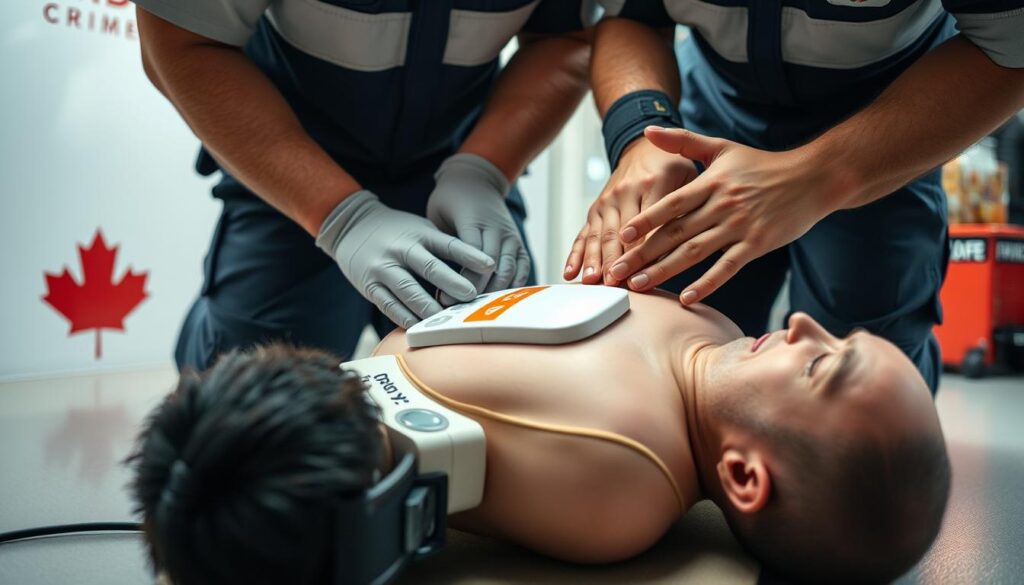
The Role of Bystanders in Rescue Efforts
Bystander intervention is often key in saving lives. When people act quickly and right, they boost survival chances for those in danger. Knowing what *bystanders* can do helps prompt lifesaving actions.
When you see an emergency, think fast. Figure out what’s happening, what you can use, and how you can help. This quick analysis can save precious time and make rescue efforts more direct.

There are two ways bystanders can help: directly and indirectly. Direct help might be doing CPR, stopping bleeding, or simple first aid. Indirect help could be calling emergency services, leading professionals to the scene, or giving important details about the crisis. Both help types are vital for saving lives.
Good communication is key in bystander intervention. Working together with other bystanders and rescue professionals makes help more effective. Quick and clear info sharing cuts down confusion and targets aid better.
Bystanders can really change outcomes in emergencies. With sharp evaluation, smart action, and smooth communication, they are crucial in boosting and supporting rescue efforts.
| Type of Bystander Intervention | Actions | Outcome |
|---|---|---|
| Direct Intervention | Performing CPR, First Aid | Stabilizes victim, increases survival rate |
| Indirect Intervention | Calling emergency services, guiding responders | Ensures timely professional aid |
| Communication | Coordinating with others, providing information | Streamlines rescue efforts |
Conclusion
As we finish our detailed chat on stopping rescue issues, it’s key to think about the big points. We aimed to give sound, usable tips for saving lives. Knowing how to act wisely in emergencies is huge for rescue results.
Remember things like the Drowning Chain of Survival and the 4 As of Rescue? They’re plans for handling water troubles safely. Learning about safe rescue moves and how to use life vests right helps avoid adding to the problem. Being ready with CPR and AEDs means you’re set for serious moments.
The part people watching play is really big. When folks step in smartly, rescue tries get way better. By backing up correctly and staying wise about ice safety, everyone does their bit. So, wrapping up, following these tips means your help in emergencies does more good than harm. By working together, big changes in crisis situations are possible.

